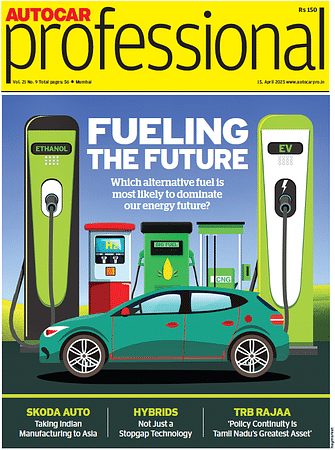Reimagining Vehicles Beyond Mobility Solutions
The future of the automotive industry is set for a major transformation, driven by electrification, evolving consumer preferences, and a shift toward customer-centric innovation. Automakers must move beyond technology-driven approaches and prioritize consumer experiences to ensure widespread adoption, especially in markets like India.
Gazing into the future of the automotive industry reveals a landscape ripe for transformation. Electrification, advanced safety features, bold new designs, and evolving consumer preferences for vehicle body types are just a glimpse of what's to come.
Vehicles are poised to transcend their traditional roles, offering more than just convenience, status symbols, togetherness, fun, and thrill for customers.
This exciting future suggests that OEMs will need to move beyond dabbling in various aspects of mobility, such as connected and autonomous vehicles, shared mobility, and multiple fuel types, including EVs and hybrids.
To fully capture the hearts and minds of consumers, the focus must shift from product and technology to customer benefits and experience. This will be essential for widespread adoption, especially in markets like India, which have seen slower uptake of these innovations.
Automotive giants are strategically positioning themselves for this future by assembling teams of experts from diverse backgrounds, including tech, design, and strategy. Their mission? To ensure that the automotive category remains exciting and relevant in an ever-evolving market. However, amidst this pursuit of innovation, it is crucial that OEMs prioritize the “customer” – understanding their evolving experiences and engagement with the world around them.
Current Scenario Impact Innovations In The Auto Industry
Let us look at two aspects which are impacting almost everyone’s life today – 1) the rise of ‘mental health’ concerns and awareness and 2) the ‘use of AI for driving efficiency’.
These have immense potential to transform the way a customer engages with their vehicles.
Let's do some crystal ball gazing and imagine how these trends can inspire OEMs to design their upcoming vehicles around themes arising out of the above.
Addressing Mental Health: A New Dimension in Vehicle Design
The rise in mental health concerns has been undeniable, affecting mood, cognition, and behavior. The WHO has even declared ‘loneliness’ a global public health concern. Many people feel disconnected and misunderstood, yearning for connection. (A trend also visible in the increasing number of pet owners).
According to Mental Health organizations, people often feel lonely even when surrounded by family or friends. This has fuelled the popularity of products and services promising mental well-being, like meditation apps, yoga services, and the entire wellness industry. The increasing awareness of the importance of mental health poses a big opportunity for the automotive industry to design its products accordingly.
Could Vehicles Evolve into Mental Health Support Systems?
Imagine OEMs designing vehicles that actively support mental well-being. Beyond being modes of transportation, these vehicles could become safe spaces for mental rejuvenation. Equipped with AI-driven mood analysis, cars could adjust their environment to soothe a stressed driver, offering everything from calming ambient lighting to personalized playlists that promote relaxation. The inclusion of features that could activate certain sensorials as per mood and state of mind could provide on-the-go mental health support. Almost like a travel companion – a ‘car-panion.’
Envisioning the ‘Carpanion’ of the Future
Picture this: as you enter your vehicle, a friendly voice-bot performs a mood check. If you express feelings of dullness, loneliness, or boredom, it might suggest playing upbeat music, adjusting the lighting, or resuming your favorite audiobook. It could even switch to manual transmission for those seeking a more engaging driving experience or recommend a nearby café for a quick treat. The car might release soothing fragrances based on your mood and adjust the temperature for maximum comfort. It could suggest a quick snack from the refrigerator or a nearby store, depending on your mood.
Consider engaging in a conversation with your car about the day's challenges, helping you release stress and lift your spirits. In more serious situations, it could monitor your vitals, pause the vehicle, and contact a doctor if needed.
What consumers are seeking from OEMs is a car that understands them—a true Carpanion. The result? A happier, calmer self upon arriving at your destination.
Leveraging AI for Enhanced Efficiency in Personal Vehicles
Have you ever driven past the market and forgotten to pick up the dry cleaning? Or missed stopping at your favourite café because you were too late? With increasing commuting time, drivers spend significant amounts of time in their vehicles. It could be a delight if this time could be used more productively than just waiting in traffic or scrolling through social media.
OEMs could introduce a “virtual manager” that assists with reminders for routine tasks and frequent stops, whether refuelling or picking up clothes for an important meeting. These are tasks that can easily be overlooked while navigating traffic or reflecting on a stressful workday.
Using AI-Driven Personalization and Automation
Beyond mundane task management, AI can offer personalized driving experiences. Imagine a vehicle that learns your daily routines and preferences, automatically adjusting the seat position, climate control, and music selection as you start your journey. AI could also analyze traffic patterns to suggest optimal routes, reducing travel time and stress.
Additionally, with advancements in autonomous driving technology, vehicles could handle more complex driving tasks, allowing drivers to have a relaxed driving experience. This transition could redefine the concept of commuting, turning travel time into productive or relaxing intervals.
Does this sound impossible? Not at all. With artificial intelligence (AI) and Internet of Things (IoT) technology, virtual assistants already exist in our homes, phones and other devices. In a vehicle, these capabilities could be integrated seamlessly into a single device, transforming how we interact with our cars and our surroundings.
There will be a lot more integration of tech and AI in our vehicles and to fully capitalise the same, OEMS must focus upon developing vehicles with features which would change the way in in which customers will view a vehicle. It would increase the engagement levels with cars very differently, for a driver, an owner or even a mere passenger. A car would no longer remain a means of commuting but become a solution to several problems, much like a mobile phone today.
Geetika Singh is Executive Director & Country Service Line Leader at Ipsos India UU. Views expressed are personal.
RELATED ARTICLES
Global E-Waste Crisis: How India Can Turn the Problem Into an Opportunity
India faces a growing e-waste challenge driven by rising consumption and technology use, but improving recycling infrast...
Optimising EV Powertrains with Simulation for Efficiency and Performance
Exploring the Role of Powertrain Optimization, Simulation Technologies, and Market Drivers in Shaping the Global and Ind...
Opinion: Air Suspension Isn't Always the Best Option
High-tech is not always better. Often, simple tech gets the job done just as well.






 22 Feb 2025
22 Feb 2025
 3653 Views
3653 Views





 Sarthak Mahajan
Sarthak Mahajan



 Autocar India
Autocar India

